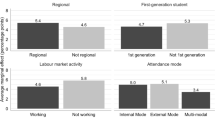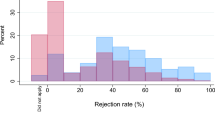Abstract
Community college transfer pathways, whereby students begin their postsecondary enrollment at a 2-year institution, are an increasingly popular option for students looking to complete a bachelor's degree. Designed to increase transfer efficiency, articulation agreements between community colleges and 4-year institutions provide structured pathways for students to transition between colleges while minimizing excess credits earned and time to degree. This study examines the early effects of North Carolina’s statewide credit articulation agreement on students’ credit-earning behaviors. Using difference-in-differences and event study analyses, we use administrative data from the 16 University of North Carolina (UNC) System institutions to examine how the implementation of the Comprehensive Articulation Agreement (CAA) impacts credit accumulation for students transferring from North Carolina Community College System (NCCCS) institutions into the UNC system. We find that, in the first 4 years after implementation, the CAA decreased credit accumulation upon graduation by two to five credits for some students who were enrolled in CAA-eligible degree programs. Additionally, we found that the policy had a delayed effect with no discernable reduction in credit accumulation until 1–2 years after policy implementation.





Similar content being viewed by others
Notes
We calculated time enrolled by adding up the number of semesters a graduate spent at the four-year university. Due to the structure of our dataset, we split the academic year into three semesters: fall, spring, and summer. A student was included in the two-year group if they spent 6 or fewer semesters (2 years) at the four-year college.
To avoid problems of multicollinearity and Ashenfelter’s Dip, we excluded the year prior to policy implementation so that it served as the reference year in our models (Furquim et al. 2020).
We have included these findings in the results because the p-value for the estimate falls between the generally accepted, yet stringent, p-value of 0.05 and the less conservative p-value of 0.10. We believe the practical significance of this finding contributes to our understanding of the effects of the policy and should therefore be reported (Hubbard and Lindsay 2008).
References
“A Call to Action for the State of North Carolina” (2019). Retrieved from https://www.myfuturenc.org/wp-content/uploads/2019/04/A-Call-to-Action-Final-Report_040319.pdf.
Anderson, G., Sun, J. C., & Alfonso, M. (2006). Effectiveness of statewide articulation agreements on the probability of transfer: A preliminary policy analysis. The Review of Higher Education, 29(3), 261–291.
Angrist, J. D., & Pischke, J. S. (2008). Mostly harmless econometrics: An empiricist’s companion. Princeton: Princeton University Press.
Austin, P. C., & Stuart, E. A. (2015). Moving towards best practice when using inverse probability treatment weighting (IPTW) using the propensity score to estimate causal treatment effects in observational studies. Statistics in Medicine, 34(28), 3661–3679.
Baker, R. (2016). The effects of structured transfer pathways in community colleges. Educational Evaluation and Policy Analysis, 38(4), 626–646.
Baum, S., Ma, J., & Payea, K. (2013). Education pays 2013. Washington, DC: The College Board.
Belfield, C., Fink, J., & Jenkins, P. D. (2017). Is it really cheaper to start at a community college? The consequences of inefficient transfer for community college students seeking bachelor’s degrees. Retrieved December 2, 2018 from https://ccrc.tc.columbia.edu/publications/really-cheaper-start-at-community-college-consequences-inefficient-transfer.html.
Carnevale, A. P., Smith, N., & Strohl, J. (2013). Recovery: Job growth and education requirements through 2020. Washington, DC: Georgetown University Center on Education and the Workforce.
Cohen, A. M. (1996). Orderly thinking about a chaotic system. In T. Rifkin (Ed.), Transfer and articulation: Improving policies to meet new needs (New Directions for Community Colleges, No. 96, pp. 25–34). San Francisco: Jossey-Bass.
Cullinane, J.P. (2014) The path to timely completion: Supply- and demand-side analyses of time to bachelor's degree completion (Doctoral dissertation). Retrieved from The University of Texas at Austin Texas ScholarWorks.
Dowd, A. C. (2003). From access to outcome equity: Revitalizing the democratic mission of the community college. The ANNALS of the American Academy of Political and Social Science, 586(1), 92–119.
Dynarski, S. (2003). Does aid matter?: Measuring the effect of student aid on college attendance and completion. The American Economic Review, 91(1), 279–288.
Fink, J. (2017). Visualizing the many routes community college students take to complete a bachelor’s degree. Retrieved from https://ccrc.tc.columbia.edu/blog/visualizing-many-routes-bachelors-degree.html
Fink, J., Jenkins, D., Kopko, E., & Xiaotao Ran, F. (2018) Using data mining to explore why community college transfer students earn bachelor's degrees with excess credits. CCRC Working Paper, 100.
Furquim, F., Corral, D., & Hillman, N. (2020). A primer for interpreting and designing difference-in-differences studies in higher education research. In L. W. Perna (Ed.), Higher Education: Handbook of Theory and Research (Vol. 35, pp. 2–53). Cham: Spinger.
Ginder, S. A., Kelly-Reid, J. E., & Mann, F. B. (2017). Enrollment and employees in postsecondary institutions, fall 2016; and financial statistics and academic libraries, fiscal year 2016. First Look (Provisional Data). NCES 2018-002. National Center for Education Statistics.
Herndon, J., Kaiser, J., & Creamer, D. (1996). Student preferences for advising styles in community college environments. Journal of College Student Development, 37(6), 637–648.
Higgins, C. S., & Katsinas, S. G. (1999). The relationship between environmental conditions and transfer rates of selected rural community colleges: A pilot study. Community College Review, 27(2), 1–25.
Hodara, M., Martinez-Wenzl, M., Stevens, D., & Mazzeo, C. (2017). Exploring credit mobility and major-specific pathways: A policy analysis and student perspective on community college to university transfer. Community College Review, 45(4), 331–349.
Horn, L., & Weko, T. (2009). On track to complete?: A taxonomy of beginning community college students and their outcomes 3 years after enrolling 2003–04 through 2006. Washington, DC: National Center for Education, Institute of Education Sciences, US Department of Education.
Hubbard, R., & Lindsay, R. M. (2008). Why P values are not a useful measure of evidence in statistical significance testing. Theory & Psychology, 18(1), 69–88. https://doi.org/10.1177/0959354307086923
Jaeger, A. J., Dunstan, S. B., & Dixon, K. G. (2015). College student access: How articulation agreements support rural students. Peabody Journal of Education, 90(5), 615–635.
Jurgens, J. C. (2010). The evolution of community colleges. College Student Affairs Journal, 28(2), 251.
Khandker, S. R., Koolwal, G. B., & Samad, H. A. (2010). Handbook on impact evaluation: Quantitative methods and practices. Washington, DC: World Bank.
King, G. (2019). A path toward completion? The impact of statewide articulation agreements on enrollment and attainment. Unpublished doctoral dissertation,NC State University, Raleigh, NC
Kramer, D. A., Holcomb, M. R., & Kelchen, R. (2018). The costs and consequences of excess credit hours policies. Educational Evaluation and Policy Analysis, 40(1), 3–28.
Leu, K. (2017). Beginning college students who change their majors within 3 years of enrollment. Retrieved from https://nces.ed.gov/datapoints/2018434.asp
McDonough, P. M. (1997). Choosing colleges: How social class and schools structure opportunity. Albany: State University of New York Press.
Monaghan, D. B., & Attewell, P. (2015). The community college route to the bachelor’s degree. Educational Evaluation and Policy Analysis, 37(1), 70–91.
Murnane, R. J., & Willett, J. B. (2011). Methods matter: Improving causal inference in educational and social science research. Oxford: Oxford University Press.
National Center for Education Statistics (2016). National postsecondary student aid study: 2016 undergraduates. National Center for Education Statistics. Retrieved from https://nces.ed.gov/datalab/powerstats/pdf/npsas2016ug_subject.pdf
North Carolina Community Colleges System (2014). 2014 Comprehensive articulation agreement. Retrieved from https://www.nccommunitycolleges.edu/academic-programs/college-transferarticulation-agreements/comprehensive-articulation-agreement-caa
North Carolina Community Colleges System. (n.d.a) Combined course library. Retrieved from https://www.nccommunitycolleges.edu/academic-programs/combined-course-library.
North Carolina Community Colleges System (2020). FY 2019–20 state aid allocations and budget policies. Retrieved from https://www.nccommunitycolleges.edu/sites/default/files/basic-pages/finance-operations/0.budgetpackagetest_combined_collegeprint.pdf
North Carolina Community Colleges System. (n.d.b.). Get the facts. Retrieved from https://www.nccommunitycolleges.edu/get-facts
North Carolina Community Colleges System. (n.d.c). Mission & history. Retrieved September 23, 2019 from https://www.nccommunitycolleges.edu/mission-history
Orozco, G. L., Alvarez, A. N., & Gutkin, T. (2010). Effective advising of diverse students in community colleges. Community College Journal of Research and Practice, 34(9), 717–737. https://doi.org/10.1080/10668920701831571
Perna, L. W., & Thomas, S. L. (2006). A framework for reducing the college success gap and promoting success for all. National Symposium on Postsecondary Student Success: Spearheading a Dialog on Student Success. Retrieved from https://repository.upenn.edu/gse_pubs/328
Perna, L. W., & Thomas, S. L. (2008). Theoretical perspectives on student success: Understanding the contributions of the disciplines. ASHE Higher Education Report, 34(1), 1–87.
Pew Research Center (2018). Internet/broadband fact sheet. Retrieved from http://www.pewinternet.org/fact-sheet/internet-broadband/
Provasnik, S., & Planty, M. (2008). Community colleges: Special supplement to the condition of education 2008. Statistical Analysis Report. NCES 2008-033. National Center for Education Statistics.
Riegle-Crumb, C. (2010). More girls go to college: Exploring the social and academic factors behind the female postsecondary advantage among hispanic and white students. Research in Higher Education, 51(6), 573–593.
Roksa, J. (2006). States, schools and students: Contextualizing community college outcomes. Unpublished doctoral dissertation, Department of Sociology, New York University, New York.
Roksa, J., & Keith, B. (2008). Credits, time, and attainment: Articulation policies and success after transfer. Educational Evaluation and Policy Analysis, 30(3), 236–254.
S.B. 225. SL 2019–68. Senate regular session. (NC 2019).
Shapiro, D., Dundar, A., Huie, F., Wakhungu, P. K., Yuan, X., Nathan, A., & Hwang, Y. (2017). Tracking transfer: Measures of effectiveness in helping community college students to complete bachelor’s degrees. Signature Report, 13, 1–31.
Stern, J. M. (2016). The effect of articulation agreements on community college transfers and bachelor’s degree attainment. Community College Journal of Research and Practice, 40(5), 355–369.
Texas Higher Education Coordinating Board (2001). Transfer issues advisory committee report: Identifying and closing the gaps. Report prepared by Transfer Issues Advisory Committee.
The University of North Carolina at Chapel Hill (2020) Estimated tuition and fees academic year 2019–2020. Retrieved from https://cashier.unc.edu/files/2020/07/20_21YR.pdf
The University of North Carolina & North Carolina Community College System (2014). The university of North Carolina and the NC community college system comprehensive articulation agreement report to the joint legislative education oversight committee. Retrieved from https://www.ncleg.gov/documentsites/committees/JLEOC/Reports%20Received/Archives/2014%20Reports%20Received/Comprehensive%20Articulation%20Agreement%20Final%20Report%20UNC-NCCCS%20Nov%201%202014.pdf
The State Board of Community Colleges & The University of North Carolina Board of Governors (2015). Review of the comprehensive articulation agreement that exists between constituent institutions of the North Carolina community college system and constituent institutions of the university of North Carolina. Retrieved from https://www.ncleg.gov/documentsites/committees/JLEOC/Reports%20Received/Archives/2015%20Reports%20Received/Comprehensive%20Articulation%20Agreement.pdf
The State Board of Community Colleges & The University of North Carolina Board of Governors (2018). Review of the comprehensive articulation agreement that exists between constituent institutions of the North Carolina community college system and constituent institutions of the university of North Carolina. Retrieved from https://www.ncleg.gov/documentsites/committees/JLEOC/Reports%20Received/2018%20Reports%20Received/Comprehensive%20Articulation%20Agreement.pdf
The United States Census Bureau. (2017). The digital divide: Percentage of households by broadband internet subscription, computer type, race and hispanic origin. Retrieved from https://www.census.gov/library/visualizations/2017/comm/internet.html
Umbach, P. D., Tuchmayer, J. B., Clayton, A. B., & Smith, K. N. (2019). Transfer student success: Exploring community college, university, and individual predictors. Community College Journal of Research and Practice, 43(9), 599–617.
Wing, C., Simon, K., & Bello-Gomez, R. A. (2018). Designing difference in difference studies: Best practices for public health policy research. Annual Review of Public Health, 39, 453–469.
Xu, D., Jaggars, S. S., Fletcher, J., & Fink, J. E. (2018). Are community college transfer students “a good bet” for 4-year admissions? Comparing academic and labor-market outcomes between transfer and native 4-year college students. The Journal of Higher Education, 89(4), 478–502.
Zeidenberg, M. (2015). Valuable learning or “spinning their wheels”? Understanding excess credits earned by community college associate degree completers. Community College Review, 43(2), 123–141.
Acknowledgements
We would like to thank our UNC System Office, and in particular Dr. David English and Dr. Diane Marian, and the North Carolina Community College System Office colleagues for supporting this research. We also thank our Belk Center colleagues, John Fink at the Community College Research Center, Dr. Nick Bowman at the University of Iowa, and Dr. Rob Toutkoushian at the University of Georgia for their suggestions on early versions of this manuscript. Finally, to our colleagues in North Carolina working with transfer students day in and day out, thank you for what you do to support students.
Author information
Authors and Affiliations
Corresponding author
Additional information
Publisher's Note
Springer Nature remains neutral with regard to jurisdictional claims in published maps and institutional affiliations.
Rights and permissions
About this article
Cite this article
Worsham, R., DeSantis, A.L., Whatley, M. et al. Early Effects of North Carolina’s Comprehensive Articulation Agreement on Credit Accumulation Among Community College Transfer Students. Res High Educ 62, 942–975 (2021). https://doi.org/10.1007/s11162-021-09626-y
Received:
Accepted:
Published:
Issue Date:
DOI: https://doi.org/10.1007/s11162-021-09626-y




